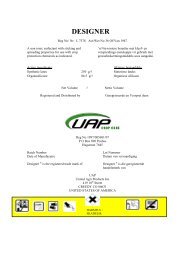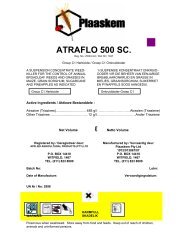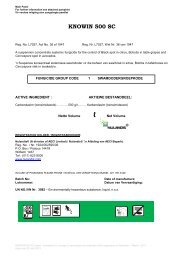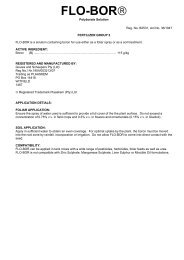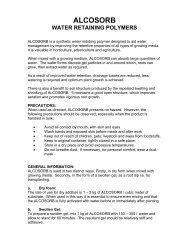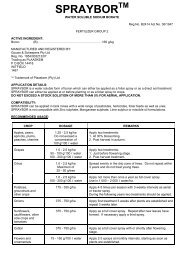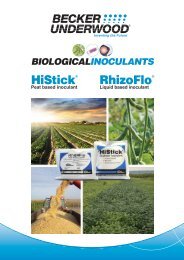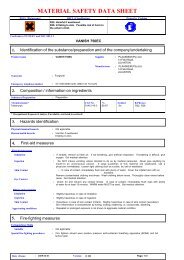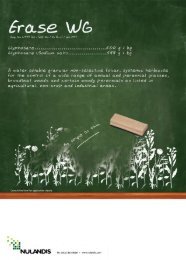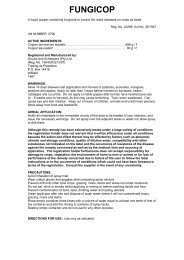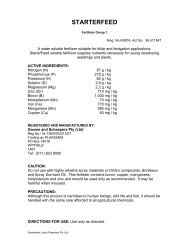MATERIAL SAFETY DATA SHEET - Nulandis
MATERIAL SAFETY DATA SHEET - Nulandis
MATERIAL SAFETY DATA SHEET - Nulandis
You also want an ePaper? Increase the reach of your titles
YUMPU automatically turns print PDFs into web optimized ePapers that Google loves.
<strong>MATERIAL</strong> <strong>SAFETY</strong> <strong>DATA</strong> <strong>SHEET</strong>DSCL (Pictograms) DSCL (Classification) Protective ClothingR20/21- Harmful by inhalation and in contact with skin.R36/37/38- Irritating to eyes, respiratory system andskin.R50 - Very toxic to aquatic organismsR57 – Toxic to beesCYPERIN1. Identification of the substance/preparation and of the company/undertakingProduct name : CYPERIN Supplier : NULANDIS (Pty) Ltd.14 Field Road,LILIANTONSynonyms: Insecticide.Manufacturer :NULANDIS (Pty) Ltd.14 Field Road,LILIANTONEmergency telephone number: 011-823-8000 (o/h), 0800 147 112 (a/h)2. Composition / information on ingredientsSubstance/Preparation: PreparationChemical name*CAS No.%SymbolR-Phrases1) Cypermethrin2) Xylene52315-07-81330-20-721-2560-70Xn, NXnR20/22, R36/37/38,R50, R57R10, R20/21* Occupational Exposure Limit(s), if available, are listed in section 83. Hazards identificationPhysical/chemical hazardsHuman health hazards :: Flammable.Explosive when mixed with oxidizing substances.Irritating to eyes, respiratory system and skin.4. First-aid measuresFirst-Aid measuresInhalationIngestion :Skin Contact :Eye Contact :: If inhaled, remove to fresh air. If not breathing, give artificial respiration.oxygen. Get medical attention.If breathing is difficult, giveDo NOT induce vomiting unless directed to do so by medical personnel. Never give anything by mouthto an unconscious person. If large quantities of this material are swallowed, call a physician immediately.Loosen tight clothing such as a collar, tie, belt or waistband.In case of contact, immediately flush skin with plenty of water for at least 15 minutes while removingcontaminated clothing and shoes. Cover the irritated skin with an emollient. Cold water may beused.Wash clothing before reuse. Thoroughly clean shoes before reuse. Get medical attention.Check for and remove any contact lenses. In case of contact, immediately flush eyes with plenty ofwater for at least 15 minutes. Cold water may be used. Get medical attention.Effects and symptomsInhalationIngestionSkin ContactEye ContactAggravating conditions:::::Harmful in case of inhalation. Non-corrosive for lungs.Slightly hazardous in case of ingestion.Harmful in case of skin contactHazardous in case of eye contact (irritant).Repeated exposure to a highly toxic material may produce general deterioration of health byan accumulation in one or many human organs.Date of issue : 2011/11/09 Version: 4 Page: 1/4
CYPERIN5. Fire-fighting measuresExtinguishing MediaSuitable :Hazardous thermal (de)compositionproducts:Flammable liquid, soluble or dispersed in water.SMALL FIRE: Use DRY chemical powder.LARGE FIRE: Use alcohol foam, water spray or fog. Cool containing vessels with water jet in order toprevent pressure build-up, autoignition or explosion.These products are carbon oxides (CO, CO 2), nitrogen oxides (NO, NO 2...), halogenated compounds.Special fire-fighting proceduresProtection of fire-fighters :6. Accidental release measures: Fire fighters should wear positive pressure self-contained breathing apparatus (SCBA) and full turnoutgear.Be sure to use an approved/certified respirator or equivalent.Personal precautions : Boots. Gloves. Eye protection.Environmental Precautionsand Clean-up Methods:Flammable liquid.Keep away from heat. Keep away from sources of ignition. Stop leak if without risk. Absorb with DRYearth, sand or other non-combustible material. Do not touch spilled material. Prevent entry into sewers,basements or confined areas; dike if needed. Be careful that the product is not present at aconcentration level above TLV. Check TLV on the MSDS and with local authorities.7. Handling and storageHandlingStorage :Packaging materialsRecommended useEngineering measuresHygiene measures :Occupational Exposure Limits :: Keep container dry. Keep away from heat. Keep away from sources of ignition. Do not ingest. Do notbreathe gas/fumes/ vapor/spray. Avoid contact with eyes. If ingested, seek medical advice immediatelyand show the container or the label. Keep away from incompatibles such as oxidizing agents.Store in a segregated and approved area. Keep container in a cool, well-ventilated area. Keep containertightly closed and sealed until ready for use. Avoid all possible sources of ignition (spark or flame).: ¡Use original container.¡8. Exposure controls/personal protectionIngredient Name: Provide exhaust ventilation or other engineering controls to keep the airborne concentrations of vaporsbelow their respective threshold limit value. Ensure that eyewash stations and safety showers areproximal to the work-station location.Wash hands, forearms, and face thoroughly after handling compounds and before eating, smoking, usinglavatory, and at the end of day.Occupational Exposure Limits1) Cypermethrin Tech No occupational exposure limits have been established for cypermethrin by OSHA, NIOSH or ACGIH.Personal protective equipmentRespiratory systemSkin and bodyHandsEyes::::Vapor respirator.Full suit.Chemical resistant gloves.Chemical splash goggles.9. Physical and chemical propertiesPhysical stateColorOdorBoiling PointMelting PointDensity::::::Liquid.Light yellow.Aromatic>150°C (212°F)n/a0.94 g/cm3 at 20°C (68°F)Date of issue : 2011/11/09 Version: 4 Page: 2/4
CYPERINVapor DensityVapor PressureSolubilityOctanol/water partition coefficientpHFlash point::::::The highest known value is 3.66 (Air = 1) (Xylene).The highest known value is 0.8 kPa (@ 20°C) (Xylene).Easily soluble in methanol, diethyl ether, n-octanol, acetone. Emulsifies in waterThe product is equally soluble in oil and water.7 [Neutral.]45°C (113F) – Class II Combustible liquid (Determined for formulation)Flammability (solid, gas) :Autoignition temperatureExplosive properties::Lower explosion limit :Extremely flammable in presence of oxidizing materials.Highly flammable in presence of open flames, sparks and static discharge.Slightly flammable to flammable in presence of heat.Non-flammable in presence of shocks, of reducing materials, of combustible materials, of organicmaterials, of metals, of acids, of alkalis, of moisture.The lowest known value is 465.6°C (870.1°F) (Hydrocarbon Petroleum aromatic).Extremely explosive in presence of open flames and sparks, of oxidizing materials.Explosive in presence of heat.Non-explosive in presence of shocks, of reducing materials, of combustible materials, oforganic materials, of metals, of acids, of alkalis, of moisture.The greatest known range is LOWER: 4% UPPER:
CYPERINProper shipping nameIMDG ClassPacking GroupIMDG label::::Pyrethroid pesticide, liquid, toxic, flammable6.1, Subsidiary Risk 3IIIAirProper shipping name:UN/ID Number:IATA-DGR Class:IATA label :Pyrethroid pesticide, liquid, toxic, flammable3351CLASS 6.1: Toxic substance,Subsidiary Risk 3Inland waterwaysProper shipping nameADNR ClassificationUN/NA (Europe) ADNRPacking GroupADNR label:::::Pyrethroid pesticide, liquid, toxic, flammableCLASS 6.1: Toxic substance,Subsidiary Risk 3.3351III15. Regulatory informationEU RegulationsHazard symbol(s) :ClassificationRisk Phrases::IrritantR20/21- Harmful by inhalation and in contact with skin.R36/37/38- Irritating to eyes, respiratory system and skin.R50 - Very toxic to aquatic organisms R57 – Toxic to beesSafety Phrases :S2- Keep out of the reach of children. S24- Avoid contact with skin.S37- Wear suitable gloves.S46- If swallowed, seek medical advice immediately and show this container or label.16. Other informationHISTORYDate of printingDate of issueDate of Previous IssueVersionPrepared by:::::2011/11/092010/09/014Notice to ReaderTo the best of our knowledge, the information contained herein is accurate. However, neither the above named supplier nor any of its subsidiariesassumes any liability whatsoever for the accuracy or completeness of the information contained herein.Final determination of suitability of any material is the sole responsibility of the user. All materials may present unknown hazards and should beused with caution. Although certain hazards are described herein, we cannot guarantee that these are the only hazards that exist.Date of issue 2011/11/09.Version: 4Page: 4/4



